#learn photography
Text

Of course! Here's the adapted welcome post for Tumblr:
📸 Welcome, fellow photography enthusiasts, to #FeelGracePhoto! 🌟
I'm absolutely thrilled to kick off this visual journey with you all. This Tumblr blog is your exclusive portal to the enchanting world of photography, landscapes, and exploration.
🌄 From the serene beauty of landscapes to the magic of night photography, I'm here to document my photographic adventures and share valuable insights, tips, and tricks that I've discovered along the way. Whether you're an experienced pro or just starting out in the captivating realm of photography, there's something special here for you.
🚀 Join me as we delve into new techniques, learn from our experiences, and embark on thrilling photography escapades together. Let's capture moments, evoke emotions, and unleash the full potential of our photography skills.
📝 So, let's dive right in and uncover the wonders of photography together! Feel free to share your own experiences, ask questions, or simply bask in the inspiration. Don't forget to follow me on Tumblr to stay updated on all the latest posts and join our growing community of photography enthusiasts.
👉 Get ready to embark on a visual journey like no other! Keep clicking, keep exploring, and let's create photographic magic together! 📸✨
#Photography, #LandscapePhotography, #VisualArt, #PhotoTips, #NaturePhotography, #CameraSkills, #ExploreMore, #CreativeInspiration, #PhotoEditing, #CaptureTheMoment
#photographers on tumblr#landscape#photography#nature#landscape photography#photo tips#nature photography#capturethemoment#creative inspiration#learn photography
9 notes
·
View notes
Text



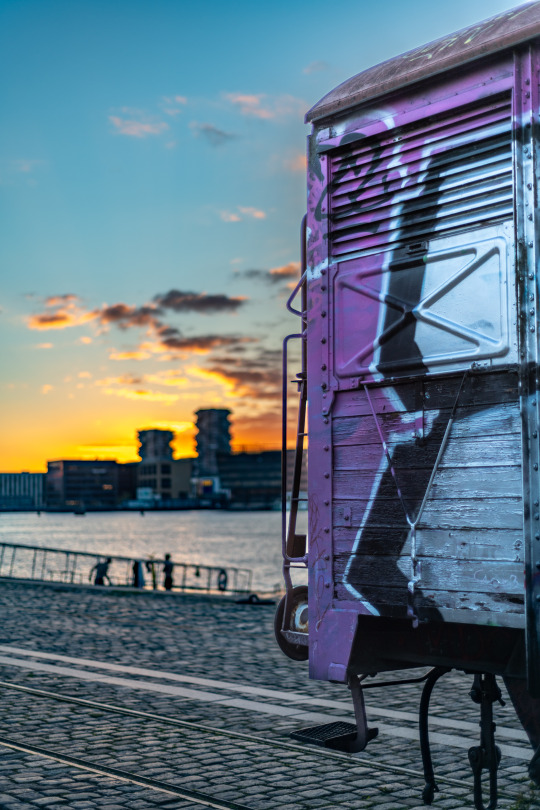






3 notes
·
View notes
Text
Something important: Don't get yourself injured and don't cause accidents if you're going to make photos on the streets and all. Always watch around enough.
#photography#learn photography#learnphotography#learning photography#learn#learning#safety#less accidents#studying photography#studying#study#photographing#for photographing#on the streets#more safety#safety measures#safetymeasures#for safety#forsafety
2 notes
·
View notes
Text
What Is Photography? Photography Definition, Meaning (2023)
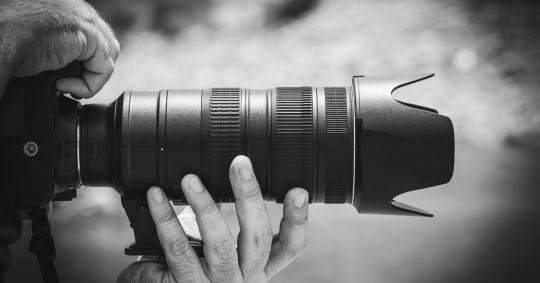
Photography is nothing but the art of capturing light with a camera to create an ‘image’. It’s a powerful medium to showcase your memories and express your creativity, and tell your stories to the world in an art form!
The term “photography” comes from the Greek words “photos” (light) and “graphos” (to draw or write). Joseph Nicéphore Niépce is the first man who took a first photograph back in 1826. Photography has made our lives have been shaped by it ever since. We have used it to document our memories, share our experiences, and tell stories.
Generally, photography has plenty of genres like Travel, Wildlife, Fashion, Documentary photography, etc… All of them serve their own purposes!
No matter what your interests & genre are, there is a type of photography for you. So what are you waiting for…? Just be curious and start taking pictures now!
Different Types of Photography?
Portrait Photography
Headshot Photography
Fashion Photography
Editorial Photography
Food Photography
Architectural Photography
Landscape Photography
Event Photography
Street Photography
Sports Photography
Product Photography
Wildlife Photography
Read More...
#photography#what is photography#photography tips#learn photography#photography for beginners#digital photography#photography tutorial#photography (visual art form)#what is photography?#art photography#photography essay#what is photography for you?#is photography art?#photography course#beginner photography#landscape photography#photography kya hai#iso photography#star photography#film photography#what is street photography#why do photography
4 notes
·
View notes
Text
A BEGINNER’S GUIDE TO SHOOTING THE NIGHT SKY: Part 1
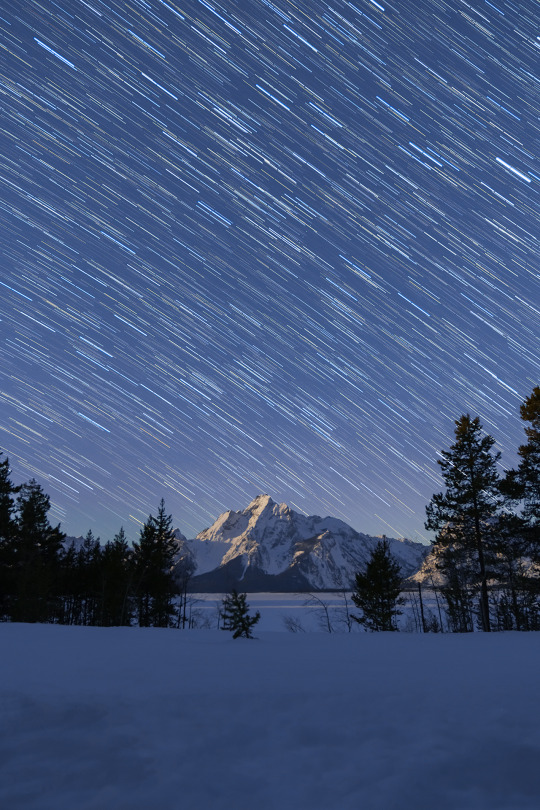
This is the first in a series of entries covering night sky photography for beginners. If you're just starting out in Astrophotography, this session will covers what gear you'll need to have a successful, and enjoyable, session.
Before getting into the camera setup I used to capture star trails and the Milky Way, let's first review what items I use to capture my night skies.
THE RIGHT WEATHER
Okay, so you can't bring this with you but there's no point in venturing out if it's going to be cloudy, or worse. Be sure to check the hourly forecast in addition to the daily. Just because it's cloudy at sunset doesn't mean those clouds won't move out of the area before the stars come out (and, if shooting the Milky Way, you may have several hours before it rises, well after sunset).
THE RIGHT CAMERA
I use a Sony a7r iv, a full frame, 61mp camera body. You'll want a body that can handle higher ISOs without adding a lot of sensor noise, especially as you'll be taking potentially hundreds of shots for star trails and building up some sensor heat.
THE RIGHT LENS
Generally speaking, you're going to want two things out of your lens for astrophotography: wide angle and fast. I usually take two lenses with me. Since I'm shooting with a full frame and not a crop sensor (APS-C senor). I take my Sony 16-35 2.8 GM and my 14mm 1.8 GM primary lens. If you have a crop sensor camera and lenses, you’ll want to bring your widest lens with the widest aperture, preferably 2.8 or wider.
THE RIGHT TRIPOD
Be wary of relying on a light weight or flimsy tripod as you don't want your camera shaking during longer exposures (or, even worse, falling over). Ideally, you'll have a model that has a center hook from which you can hang your camera bag or tripod weights to help with windy conditions. I prefer and use SLIK Tripods and ball head. You can purchase directly from Slik Tripods website or on Amazon.
THE RIGHT APPS
I used PhotoPills to identify when and where the Milky Way or Polaris if I’m doing circle star trails, moon phase and position, and much more. It also has built in tools to help you: calculate your maximum exposure time to avoid star trailing (accounting for your camera's sensor size and your lens' set focal length), plan for time lapses, find hyperfocal distances… and a ton more. There is a lot to absorb and play around with and, fortunately, the developers provide tutorials for using all the tools (I spent about 90 minutes watching videos the night before the group outing). The mode I found most useful, however, is the night AR (altered reality) mode. Click on this and you're taken to a live view of your surroundings with an overlay of the sky. You can use this view to scroll back and forth through times and dates to preview where the Milky Way will be in the future; a great tool to plan your shot well in advance, especially when it won't be visible until 3am! Additionally, you'll likely discover that a star finder app will be useful, if you're trying to find/identify constellations or just need help finding the North Star (and can't remember your basic education, like me).

THE RIGHT STUFF
Jump past the Milky Way for a rundown of some other items you'll need, or should consider, for night sky sessions.
TRIPOD WEIGHTS
If wind is in the forecast, consider some weighted bags for your tripod. I found some on Amazon for a good price and filled them with play sand from the local hardware store. The set I ordered has four bags, enough to place one on each tripod leg and to hang one from the tripod's center hook. If you don't want to use weighted bags, or forget them, you can always hang your camera bag from the hook in a pinch.
EXTRA CAMERA BATTERIES
More important for star trails than shooting the Milky Way but you'll want an extra battery or two. Shooting 240 30-second exposures for star trails chewed through about 70% of a fully charged battery for my Sony a7r iv, and I ended up using all three batteries I brought for the overnight session (only one was completely drained, the other two each had roughly 15-20% left). The next worst thing to not checking the weather forecast beforehand would be having perfect conditions and running out of juice halfway through your shooting.
INTERVALOMETER/WIRED REMOTE AND EXTRA BATTERIES
Another must-have for shooting star trails. Yes, you could shoot manually but who wants to stand or sit next to your camera for 2-3 hours hitting the shutter button every 30 seconds? I also discovered that the built-in interval timer on the Sony a7r iv allows for up to 9999 shots, but some cameras only allow up to 99 shots. As for batteries, the intervalometer/remote probably doesn't draw much power but, again, you don't want to get halfway through your shots only to have the batteries unexpectedly die. I always bring spare batteries and a portable battery charger just incase. It’s always nice to be prepared then not have it.
RED FLASHLIGHT/HEADLAMP
A headlamp is a must. Make sure it has a red lamp mode. Also I always carry a compact flashlight just incase- for light painting, getting around, and for emergencies - and a head lamp that has a red light option. I only used the flashlight a few times to sweep the foreground during long exposures of the Milky Way but I used the red headlamp frequently as I walked to and from my camera and my chair or car, or as I needed to check various things on my camera or intervalometer here and there through the night. Remember, ideal shooting conditions are during the new moon; between that and (hopefully) being far away from light pollution, it will be much darker than you expect!
OTHER ITEMS TO CONSIDER
Chair
Snacks/Drinks
Bug Spray
First aid kit
Balaclava (best purchase I've made for chilly nights!)
Blanket
Pillow (I caught a snooze in the back seat of my car... the pillow helped... some)
Extra memory cards
Lens cleaning tools
And a lens warmer. This is needed for those long cold nights or high humidity nights where frost or dew can form on your lens over time. There’s. I thing like shooting a 700 image star trail or time lapse and seeing the last 200-300 images are hazy due to frost or dew.
This covers what I typical bring and equipment I use for Astrophotography. You can always add to list as the nights are long, or you can always kick back while the camera is clicking away and read some more of my blogs or checkout my tutorials and adventures on YouTube. But keep that screen light away from your camera, you don’t want to introduce any unwanted light pollution!
Don’t forget to subscribe and stay update with new blogs and more!

3 notes
·
View notes
Text
Echoes of nature
I have done almost all types of photography projects but nature is my favourite subject. My photographs of nature blended with textures.
Mind the hand a series.

View On WordPress
#basic photography#earth#film photography#flower photography#flowers#island girl#LEARN PHOTOGRAPHY#mom blogger#nature#New Zealand#photography#rotuma#rotuman#self love#summer#summertime#travel
2 notes
·
View notes
Text
Exposure Triangle 2.0
I plaid around with an idea of an exposure triangle redesign this weekend.
I wanted to rework the traditional exposure triangle design, which simply assigns camera settings/ISO to each side. And so, I drew a diagram for visual learners like me that lets you trace the lines to see all the possible options for camera settings.
To me, the new design felt straightforward. Exposure Triangle 2.0 illustrates all the possible options for a hypothetical lens with an aperture range of f/2.8-f/16, shutter speeds between 1/15-1/500, and film stock options with ISOs 100-400. Here's how it works:
Trace the line from an exposure sample up: your options are all the apertures and shutter speed values that have their respective lines intersect the solid exposure line.
Well, not everyone thought this was easy or useful. I've asked for feedback on Twitter, which turned out to be very helpful. My drawing made little sense to many, and I can understand why.
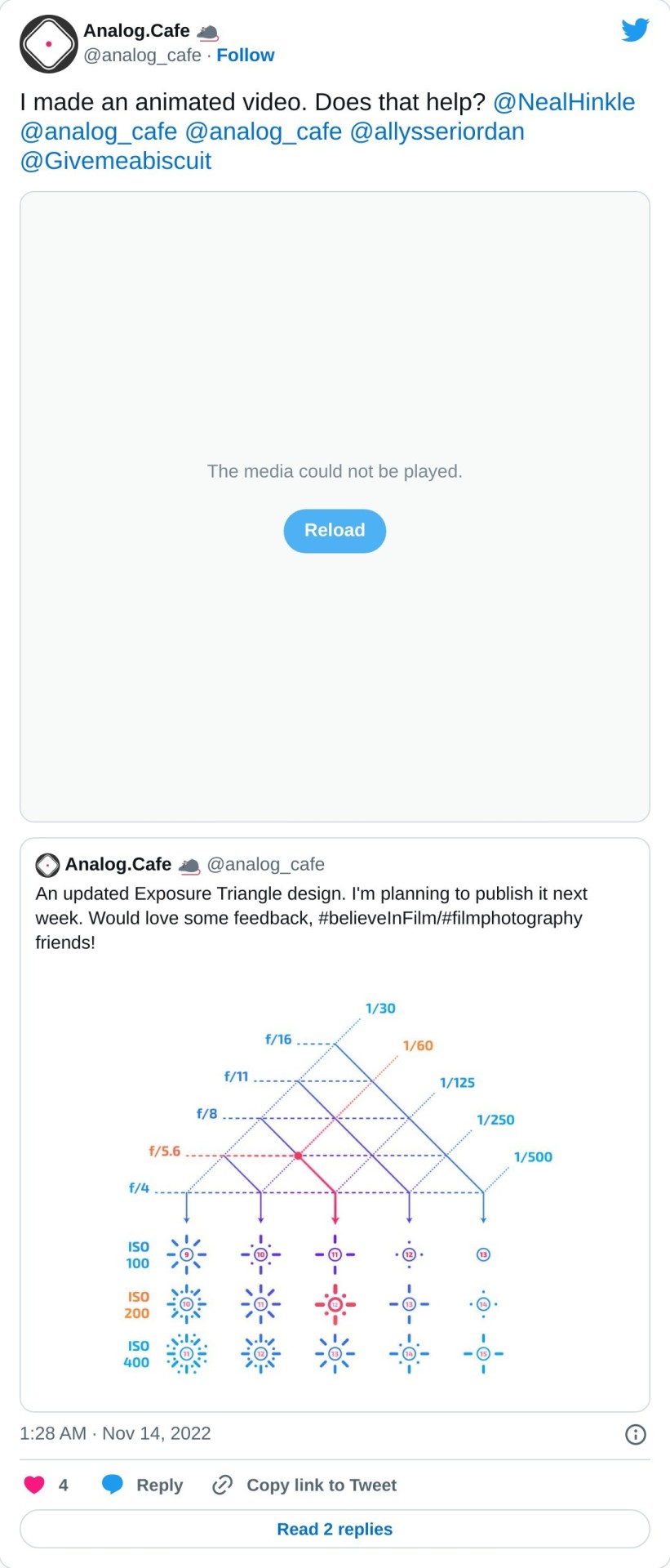
I still think that this new exposure triangle concept can be useful for a certain kind of learner, new to camera exposure settings. But it can be improved also.
Here's the final (so far) version:

Throughout the experience of collaboratively creating this, I've had some fun with After Effects — software for creating 2.5D animations and Illustrator.
These are not the tools I typically use in photography, but working with the animation suite reminded me of my blissful days as a creative director for a small business in Toronto. It was the last full-time position that allowed me to be an artist on the clock. Unfortunately, that business went under, kinda like my efforts to improve the exposure triangle.
#believeinfilm#film photography#grainisgood#filmisnotdead#ishootfilm#analog#film#photography#learn photography
4 notes
·
View notes
Text
Digital Photography Terms Every Aspiring Photographer Should Know
Digital Photography Terms Every Aspiring Photographer Should Know
As an amateur photographer, it is essential that you understand common photography terms so that you can further develop your photography skills.
From A to Z, here’s the digital photography terms glossary to help you dive more deeply into the creative field of photography.
How DSLR Cameras Work
Aperture
Aperture is the opening between the lenses (similar to the pupil of our eye) that lets the…
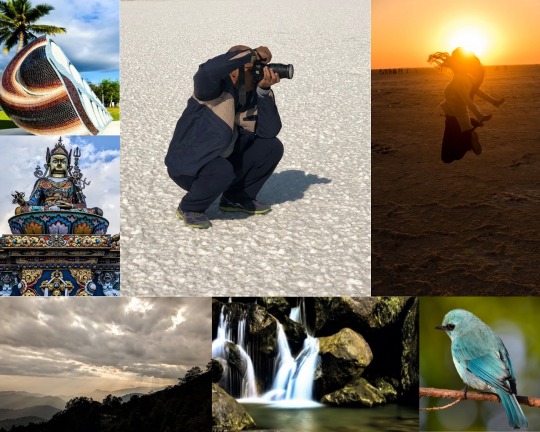
View On WordPress
#a photographer#digital photography tutorials#dslr tutorial for beginners#free online photography tutorials#free photography tutorials#glossary of digital photography terms#learn photography#Photography#photography for beginners#photography lessons#photography tutorials#photography tutorials for beginners#photography tutorials online#photography website
3 notes
·
View notes
Photo

“Pink Flamingo” by @losgiddy
This one took lots of time and I have my awesome creative directors to applaud for going all out.
We started this shoot at 11am and finished at 8pm. (Mostly because I was recording it as a film as well.) and we had issues with the smoke machine and lights but the model was very patient and professional through it all shout out to @abiolaajibola_
@essienlydia_
@tennygram77
@banji_zillionz
@diobichypes_official
#losgiddy#photography school in lagos#learn photography#learn photography in lagos#ballerina#ballet#african#lagos photographer#lagos#Lagos State#black models#melanin goddess#melanin glowing#ebony model#ebony women#pink dress#pink lady#african art#fashion photography#high fashion#women's fashion#beauty
4 notes
·
View notes
Text
Food Styling and iPhone Photography Workshop in Seattle (May 18, Saturday 2024)
Hello! I am delighted to announce that I am hosting a food styling and photography workshop for beginners with my friend and multi-talented pastry chef and photographer, Junko Mine. This is our first workshop together. It will be a fun and information-packed half-day event at my home in the View Ridge neighborhood in NE Seattle.
Junko will teach how to style a Japanese-style matcha chiffon cake (that she will bake, of course!) on beautiful ceramic pieces created by a master ceramist in Japan. I will lead the photography part and guide you through how to photograph and edit aesthetic images using an iPhone.
As a bonus, we will serve Japanese bento-style brunch as well as a gift bag filled with high-quality craft items.
Please see below for detailed information and to register. Space is limited to only 5 attendees so that we can focus better, give better personal attention, and delve deep into crafting food styling and photography.
We will close the registration as soon as the spots are filled.
Thank you for your interest, and we look forward to seeing you in May!
Rika
#food#food styling#food photography#food photographer#workshop#food photography workshop#photography#iphone#camera#learn photography#design#business#cafe#restaurant#table setting#cake decoration#seattle#seattle food photographer#Seattle pastry chef#pastry#chiffon cake#Japanese lunch#bento#japanese cake#cafe juanita#James beard#pink lady food photography#food photography award#chocolate#atelier juju
0 notes
Text
0 notes
Text
#photography#singapore#videography#creative studio#photography workshop#learn photography#photography tips#coco creative studio
0 notes
Text
youtube
#photography#best camera for photography#best photography camera#camera reviews#best camera for photography 2023#photography tips#learn photography#photography camera 2023#photography tutorial#photography for beginners#best camera#best camera for youtube and photography#camera#travel photography#photography camera#digital photography#camera for photography#photography camera 2024#2024 photography camera#camera for photography 2023#Youtube
0 notes
Text
If I am going to photograph plants and flowers, outside, then I choose a day with no wind or near no wind and enough sunlight, but not too much sunlight.
#plant photography#plantphotography#flower photography#flowerphotography#plants#flowers#photography#learn photography#learnphotography#learning photography#learn#learning#studying photography#studying#study
4 notes
·
View notes
Text
New 2024 Workshops Q1 - Lets Take It To The Streets! Destination: Milan & NYC
The focus is on the streets, and street photography to be precise. I’m very excited to announce the first series of photo walks and workshops in partnership with two of my favorite photography educators, Steve Simon, the Passionate Photographer, and Art of Intuitive Photography’s Mindy Véissid. Before I share with you these exciting opportunities to delve deep into our shared love of photography…

View On WordPress
#photoworkshops#aoip#art of intuitive photography#cameras#learn photography#mentorship#milan#NYC#photo walk#steve simon#street photography
1 note
·
View note
Video
youtube
Composition Tips for Portrait Photography you Need to Know
#youtube#portrait#composition#photography#photoshop#how to photography#learn photography#photography tips#dos and donts#compose your shot#editing#photography for all#photography tips and tricks#digital learning
0 notes